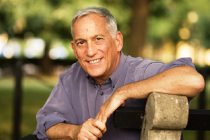Walter Isaacson: Innovation Sparked Best By Creative Collaboration
November 12, 2014

Best-selling author urges arts, humanities and technology intersection during WORLDWISE: Arts & Humanities Dean’s Lecture Series
by Courtney Mabeus
Creative innovation requires collaboration between multiple partners from varied backgrounds—not just the sciences, biographer Walter Isaacson told a crowd gathered on Monday in The Clarice’s Gildenhorn Recital Hall.
Isaacson, a former editor for Time magazine who also served as CEO of CNN, appeared as the first installment of the 2014-’15 WORLDWISE: Arts & Humanities Dean’s Lecture Series. Isaacson spoke with Sheri Parks, associate dean for research, interdisciplinary scholarship and programming for the University of Maryland’s College of Arts and Humanities, about his most recent book, “The Innovators: How a Group of Inventors, Hackers, Geniuses and Geeks Created the Digital Revolution.”
“The Innovators” traces the evolution of computing and the Internet and how revolutionary ideas transform society. In conversation with Parks and during a question and answer session that followed, Isaacson argued that the future belongs to those who can appreciate the arts, humanities and the sciences.
The idea that lasting innovation requires arts and humanities to be infused in its creation first occurred to Isaacson while working on his biography of Steve Jobs a few years ago, he said. Jobs told Isaacson he felt confounded as a child who loved poetry and arts, but also technology. That later translated into Apple becoming one of the largest technology companies in the world, known not only for its products but also for its design.
“It’s at that intersection that makes our hearts sing,” Issacson said. He added that the theme he took away from working with Jobs is that “beauty matters.”
“The Innovators” continues on that idea. Isaacson begins his writing on today’s innovators through the story of Ada Lovelace, the daughter of Lord Byron, who is also known as a pioneer of computer programming. Lovelace, who was trained in the sciences in addition to humanities, traveled the British countryside in the 1800s and noticed that punch cards used to operate weaving looms could also be translated for use in art and music. It was Lovelace’s understanding of and appreciation for not only the humanities, but also for math and science that allowed that insight, Isaacson said.
“That is why Ada is the patron saint and defining character in this book,” Isaacson said.
Isaacson, who is currently CEO and President of the Washington, D.C.-based Aspen Institute, urged the continued dismantling of silos separating the arts and humanities from those who work in the math and sciences to encourage continued innovation.
ABOUT THE SERIES: The WORLDWISE: Arts & Humanities Dean's Lecture Series provides an opportunity for the college faculty, students and staff to join together with colleagues across campus for stimulating conversation about issues that cross our disciplines. Lectures and performances may address either enduring or emerging questions central to the arts and humanities, or questions arising from other disciplines to which the arts and humanities might speak.
Terry Tempest Williams, environmental humanist, author and activist, is the next scheduled speaker in the series. That event is scheduled for April 16, 2015 at 5:30 p.m. More information will be released as it becomes available.

